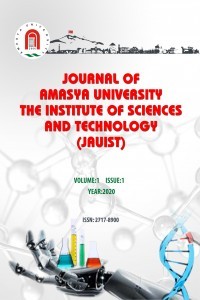OZON JENERATÖRÜ VE OZON ÜRETİMİ
Ozonun çok aktif bir oksidan ve kuvvetli bir antimikrobiyal özelliği olması bakımından birçok sektörde kendine uygulama alanı bulmuştur. Uzun bir süredir diş hekimliğinde, tıbbi laboratuvarlarda, hastanelerin atık sulara karışan kimyasal atıklarının yok edilmesinde, gıda ürünlerinin ozonlanarak raf ömrünün uzatılmasında, şehir içme sularının arıtılmasında, havuzların ve balık akvaryumlarının artırtılmasında kullanılmaktadır. Ozonun uygulandığı alan ve sektöre göre değişik miktarlarda kullanılabilmesi için laboratuvarda yapay yöntemlerle üretilmesine ihtiyaç vardır. Bu çalışmada Amasya Üniversitesi Teknik Bilimler Meslek Yüksekokulunda öğrencilere bilgi ve teknik beceri kazandırmayı hedefledik. Bu hedef çerçevesinde önemli miktarlarda ozon elde edebilmek için korona deşarj prensibi ile çalışan bir ozon jeneratörünün modelini kullanıma sunduk. Ortaya konan çalışmanın hedefi ozon jeneratörünün faydalarını tanıtmak ve uygulama alanları hakkında insanları bilinçlendirmek amaçlanmıştır.
Anahtar Kelimeler:
Ozon, Ozon Jeneratörü, Korona Boşalması
OZONE GENERATOR AND OZONE GENERATION
Because ozone is a very active oxidizing agent and powerful antimicrobial property, it has found use in many areas. It has long been used in dentistry, in medical laboratories, in cleaning up chemical waste mixed with hospital sewage, in extending the shelf life of food through ozonation, in cleaning urban drinking water, in raising pools and fish aquariums. So that ozone can be used in different amounts depending on the area of application and industry, it must be produced in the laboratory using artificial methods. The aim of this study was to impart knowledge and technical skills to the students at the vocational school for technical sciences at Amasya University. As part of this goal, we presented a model of an ozone generator that works on the corona discharge principle to generate significant amounts of ozone. The aim of the study is to present the advantages of the ozone generator and to raise awareness for the areas of application.
Keywords:
Ozone, Ozone Generator, Corona Discharge.,
___
- 1. Sandermann Jr, H. (1996). Ozone and plant health. Annual review of phytopathology, 34(1), 347-366.
- 2. Kogelschatz, U. (1988). Process Technologies for Water treatment, edited by S. Stucki.
- 3. Danil de Namor, A. F. (2007). Water purification: from ancient civilization to the XXI Century. Water Science and Technology: Water Supply, 7(1), 33-39.
- 4. Merlet, N. (1986). Contribution A LEtude Du Mechanisme De Formation Des Trihalomethanes Et Des Composes Organohalogdnds Non Volatils Lors De La Chloration De Molecule Modules Dissertation. University de Poitiers.
- 5. Guzel-Seydim, Z. B., Greene, A. K., & Seydim, A. C. (2004). Use of ozone in the food industry. LWT-Food Science and Technology, 37(4), 453-460.
- 6. Ölmez, H., & Kretzschmar, U. (2009). Potential alternative disinfection methods for organic fresh-cut industry for minimizing water consumption and environmental impact. LWT-Food Science and Technology, 42(3), 686-693.
- 7. United States Environmental Protection Acency. (1999). Wastewater Technology Fact Sheet: Ozone Disinfection.
- ISSN: 2717-8900
- Yayın Aralığı: Yılda 2 Sayı
- Başlangıç: 2020
- Yayıncı: Amasya Üniversitesi
Sayıdaki Diğer Makaleler
H2S ORTAMINDA TAVLANMIŞ ZnS VE Mo-KATKILI ZnS NANOPARTİKÜLLERİNİN YAPISAL ÖZELLİKLERİNİN İNCELENMESİ
Ömer ŞAHİN, Sabit HOROZ, Arzu EKİNCİ
YARI-HEUSLER NaYSi BİLEŞİĞİNİN BAZI FİZİKSEL ÖZELLİKLERİ : İLK İLKELER ÇALIŞMASI
OZON JENERATÖRÜ VE OZON ÜRETİMİ
ELEKTROKOAGÜLASYON İLE SU ARITMA
Abdal-rhman Magdy ABDULLAH YOUSSEF
SU-SİLİKA YÜZEY ETKİLEŞİMİNDE PBE VE SCAN FONKSİYONLARININ KARŞILAŞTIRILMASI
